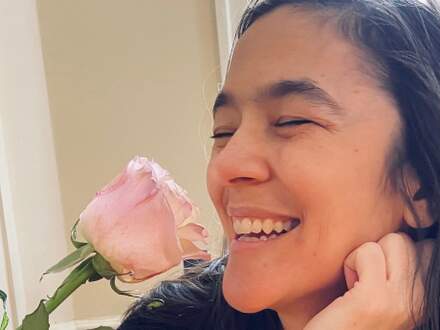
Hannah Weiner's Open House
Edited by Patrick Durgin
Kenning Editions, $14.95 (paper)
“They shut me up in Prose,” wrote Emily Dickinson, loudly and silently and privately and indelibly, and yet they didn’t—not in prose or otherwise. The same is true for Hannah Weiner, who, twenty years after the end of her schizophrenia-riven, psychic, art-committed life, continually exceeds well-meaning attempts to preserve her. Her own prose, occupied as it is by the voices of hallucinated “silent teachers,” continually tests and knocks against the visual boundaries of text as it attempts to create an audial-visionary experience no conventional prose could hold. The Internet, with its capacity for assemblage, co-authorship, and multiple media may be the best mode for hosting Weiner, who made the hosting of corporeal and non-corporeal collaborators the mainstay of her art. “We have unknown collaborators,” she wrote in an early piece.
Weiner’s ceaseless effort to find a format adequate to her experiences as a psychic medium resulted in the ever-changing forms and surfaces of her work. As a result, her friends’ and advocates’ efforts to build her a legacy make for a series of exhaustive, self-sacrificing labors that, while failing to fix a monument, create something better: a living zone in which Weiner emerges from between and among the Web sites, essays, and books assembled in her honor. Hannah Weiner’s Open House is the latest of these efforts, a labor of love on the part of Kenning Editions editor Patrick Durgin and poet-critic Charles Bernstein, Weiner’s close friend and executor who encouraged Durgin to take up this and earlier projects working with Weiner’s archival materials and published texts. For this new volume Durgin has assembled press releases, artist statements, early lyrics, and published texts, including the naval code-script for Weiner’s code poem performances, which were staged with the U.S. Coast Guard. Durgin also includes excerpts from her clairvoyant or “clair-style” journalistic poems in which she replicated via typewriter the commands and commentary she saw written on her body, clothing, walls, furniture, and other surfaces. While the book lacks much of the chronological apparatus and contextualization that a go-to introduction to Weiner would require, it enriches the collective multimedia work-in-progress that is Weiner scholarship.
The title of Hannah Weiner’s Open House refers to an early performance piece in which various artists and poets opened their homes to the public over two days in October 1969. In Weiner’s account of the event, “From 3 to 26 people showed up at different places. We sat around kitchen tables, or on the floor and talked and smoked or had a party. I met new friends.” As this project suggests, invitation is one of Weiner’s distinctive early modes, but invitation to what? What is an enclosure when it’s “open”? What is private space when it’s made public? Interestingly, although this piece involved such prominent figures as Vito Acconi, Bernadette Mayer, John Perreault, Abraham Lubelski, Marjorie Strider, and Japanese painter and performance artist Arakawa, it’s Weiner’s name that’s in the title. Its performance converts “Hannah Weiner” from a proper name, a signature, to something that does not refer to Hannah Weiner merely, but also to some 30 people.
No comments:
Post a Comment